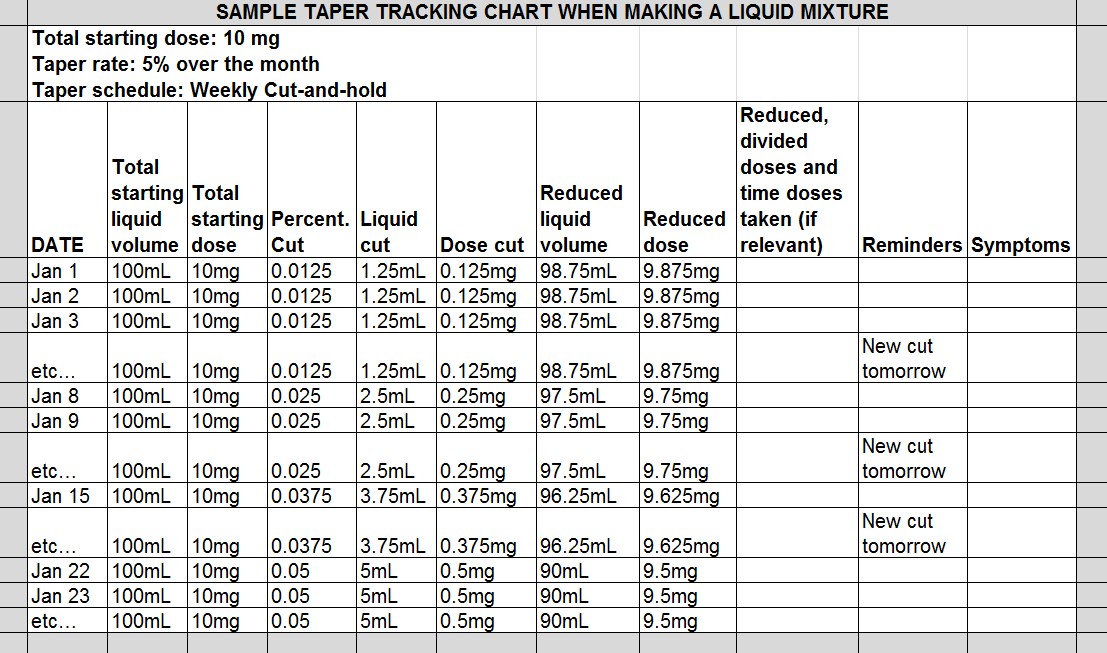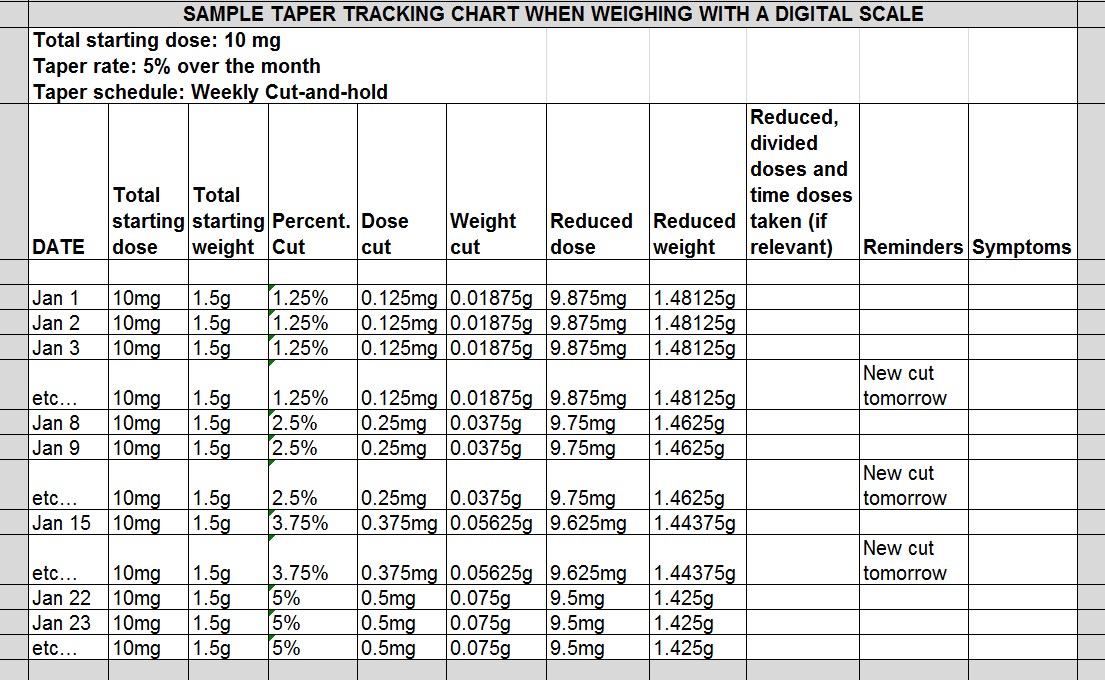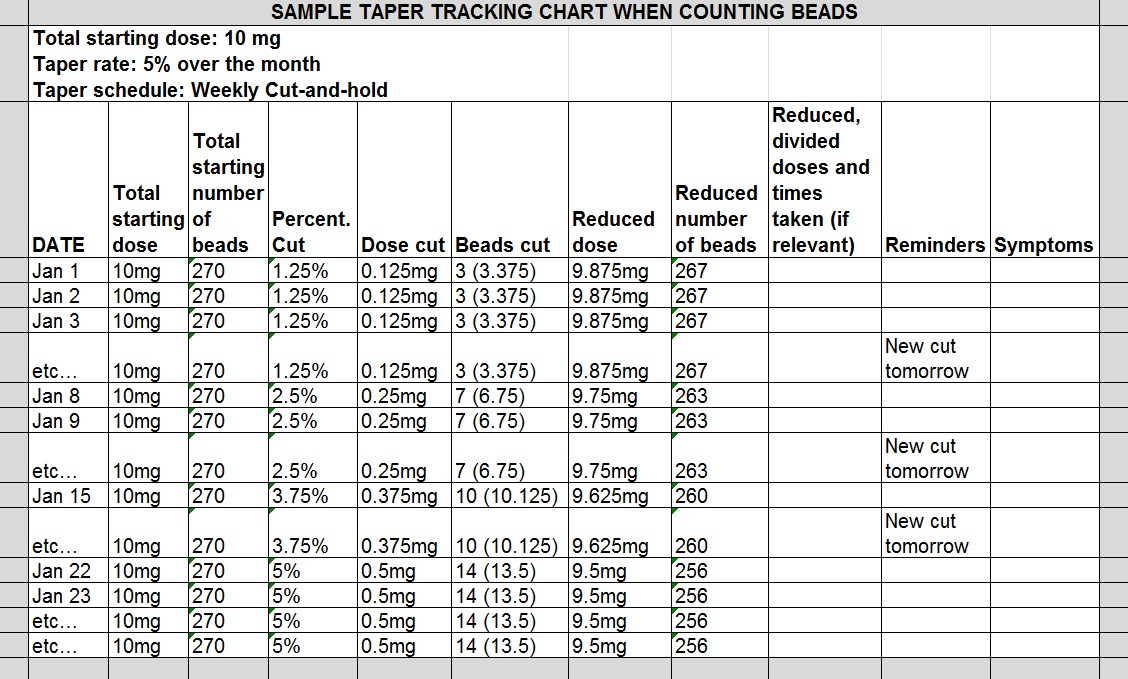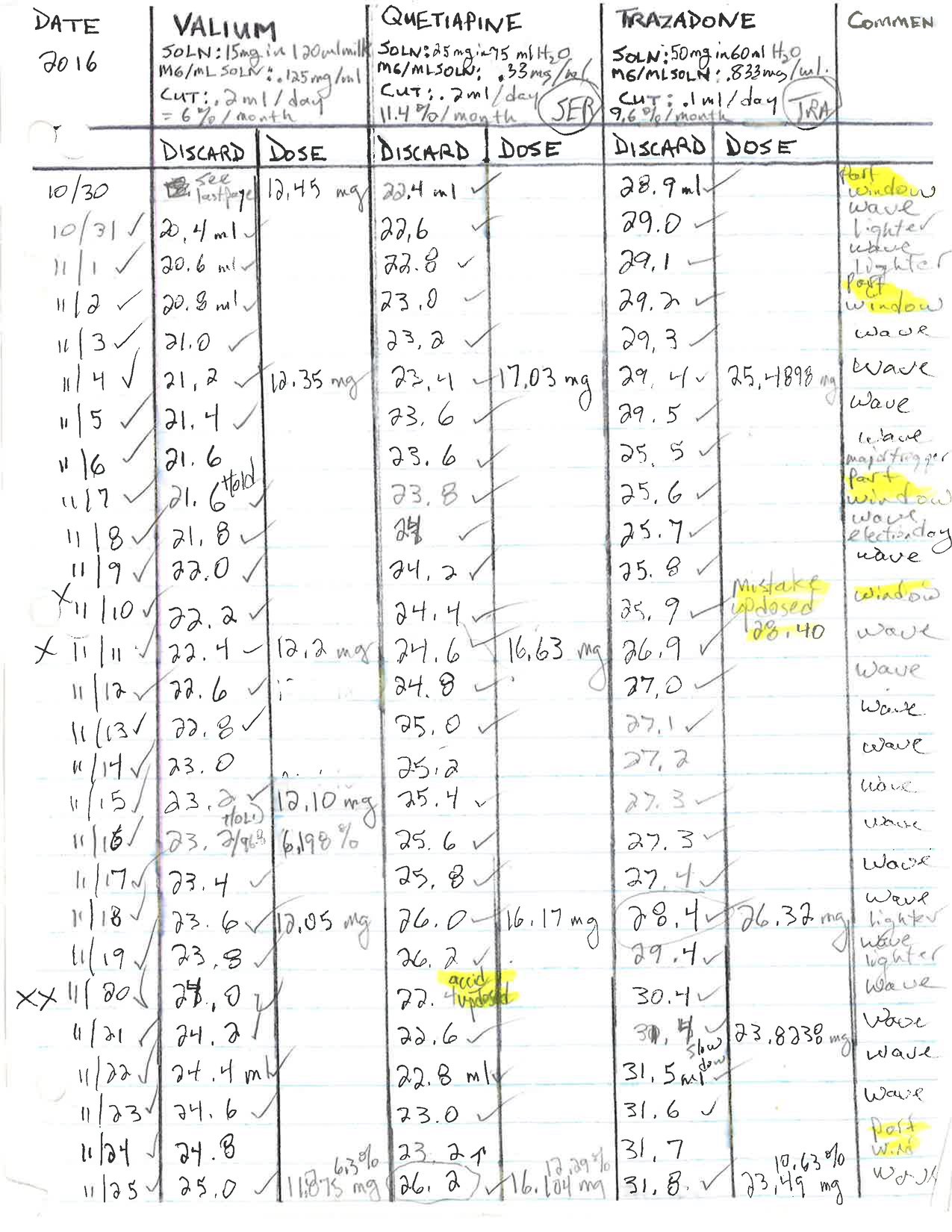Section 1- Tracking Calculations and Amounts

Let’s focus first on the section of the journal that involves recording the dates and amounts of your doses. Each taper method requires tracking slightly different information, so we’ve provided a distinct section for each method that you might choose. Note that, of course, you’ll actually have to do the required math calculations for your taper before you’ll be able to fill in a chart of this kind – our numbers are samples only. And in all of our examples, we include all of the numbers that are necessary for keeping track of a taper – once you feel you have a good understanding of your own process, you may not find it necessary to track the numbers in all of our suggested columns.
How to record taper dates and amounts
1. Using a liquid mixture
Important Information to Record:
- Date. Keep track of each day.
- Total starting dose. The amount of your current dose in mg in your liquid mixture from which you’ll be cutting. It may be helpful to start a new chart/page/sheet each time you are re-calculating cuts from a new starting dose (for example, at the beginning of each month); otherwise, track any changes to your starting dose within the chart/page/sheet.
- Taper rate. The percentage of your starting dose that you want to cut over a specific period of time – usually calculated for one month.
- Taper schedule. Details about the taper schedule that you are following.
- Total starting liquid volume. The total volume in mL of your liquid mixture prior to making any reduction in dose.
- Percentage cut. The percentage of cut you’re making relative to your total starting dose amount.
- Liquid cut. The amount you’re cutting in mL from the total volume of liquid mixture.
- Dose cut. The amount of active drug in mg that you’re cutting from the total dose amount.
- Reduced liquid volume. The reduced volume of liquid in mL that you’re taking with your reduced dose in it, after you make your cut.
- Reduced dose. The amount of dose in mg that you’re taking after you make your cut.
- Liquid volume for reduced, divided doses.If you’re dividing your daily dose into multiple smaller doses, then you may want to track how much liquid in mL is in each individual dose.
- Reduced, divided doses. If you’re dividing your daily dose into multiple smaller doses, then you may want to track how much active drug in mg is in each individual dose.
- Time dose(s) taken. If you’re dividing your daily dose into multiple smaller doses, then you may want to track the exact times that you take them.
- Reminders. Any important instructions or other notes you want to make for yourself.
- Symptoms. See Section 2 in this step for more information.
A chart or spreadsheet might roughly look like the one below (also attached as a PDF).

2. Using a digital scale
Important Information to Record:
- Date. Keep track of each day.
- Total starting dose. The amount of your current dose in mg from which you’ll be cutting. It may be helpful to start a new journal section/page/sheet each time you are re-calculating cuts from a new starting dose (for example, at the beginning of each month); otherwise, track any changes to your starting dose within the chart/page/sheet.
- Taper rate. The percentage of your starting dose that you want to cut over a specific period of time – usually calculated for one month.
- Taper schedule. Details about the taper schedule that you are following.
- Total starting weight.The weight of your starting dose in mg or grams. (Remember that this amount will be higher than the amount of active drug in mg, due to fillers and binders.)
- Percentage cut. The percentage of cut you’re making relative to your total starting dose.
- Dose cut. The amount of active drug in mg that you’re cutting from your total daily dose.
- Weight cut. The amount of weight in mg/grams that you’re cutting.
- Reduced dose. The amount of dose in mg that you’re taking after you make your cut.
- Reduced weight. The amount of weight in mg/grams that you’re taking after you make your cut.
- Reduced, divided doses. If you’re dividing your daily dose into multiple smaller doses, then you may want to track how much active drug in mg is in each individual dose.
- Time doses taken. If you’re dividing your daily dose into multiple smaller doses, then you may want to track the exact times that you take them.
- Reminders. Any important instructions or other notes you want to make for yourself.
- Symptoms. See Section 2 in this step for more information.
A chart or spreadsheet might roughly look like the one below (also attached as a PDF).

3. Counting beads
Important Information to Record:
- Date. Keep track of each day.
- Total starting dose. The amount of your current dose in mg from which you’ll be cutting. It may be helpful to start a new journal section/page/sheet each time you are re-calculating cuts from a new starting dose (for example, at the beginning of each month); otherwise, track any changes to your starting dose within the chart/page/sheet.
- Taper rate. The percentage of your starting dose that you want to cut over a specific period of time – usually calculated for one month.
- Taper schedule. Details about the taper schedule that you are following.
- Total starting number of beads.The average number of beads in your starting dose.
- Percentage cut. The percentage of cut you’re making on that day relative to your starting dose.
- Dose cut. The amount of dose in mg that you’re cutting.
- Bead cut. The number of beads that you’re cutting.
- Reduced dose. The amount of daily dose in mg that you’re taking after you make your cut.
- Reduced number of beads. The number of beads that you’re taking after you make your cut.
- Reduced, divided doses. If you’re dividing your daily dose into multiple smaller doses, then you may want to track how much active drug in mg is in each individual dose.
- Time doses taken. If you’re dividing your daily dose into multiple smaller doses, then you may want to track the exact times that you take them.
- Reminders. Any important instructions or other notes you want to make for yourself.
- Symptoms. See Section 2 in this step for more information.
A chart or spreadsheet might roughly look like the one below (also attached as a PDF).

4. Using a compounding pharmacy (capsules)
Important Information to Record:
- Date. Keep track of each day.
- Total starting dose. The amount of your current dose in mg from which you’ll be cutting. It may be helpful to start a new journal section/page/sheet each time you are re-calculating cuts from a new starting dose (for example, at the beginning of each month); otherwise, track any changes to your starting dose within the chart/page/sheet.
- Taper rate. The percentage of your starting dose that you want to cut over a specific period of time – usually calculated for one month.
- Taper schedule. Details about the taper schedule that you are following.
- Percentage cut. The percentage of cut that was made by the compounding pharmacy relative to your starting dose.
- Dose cut. The amount of dose that was cut by the compounding pharmacy in mg.
- Reduced dose. The amount of daily dose in mg that you’re taking after the compounding pharmacy made the reduction.
- Reduced, divided doses. If you’re dividing your daily dose into multiple smaller doses, then you may want to track how much active drug in mg is in each individual dose.
- Time doses taken. If you’re dividing your daily dose into multiple smaller doses, then you may want to track the exact times that you take them.
- Reminders. Any important instructions or other notes you want to make for yourself.
- Symptoms. See Section 2 in this step for more information.
For sample charts/sheets, see the other methods in this step.
5. Using, or making a dilution from, a manufacturer’s/compounded liquid
Important Information to Record:
- Date. Keep track of each day.
- Total starting dose. The amount of your current dose in mg from which you’ll be cutting. It may be helpful to start a new journal section/page/sheet each time you are re-calculating cuts from a new starting dose (for example, at the beginning of each month); otherwise, track any changes to your starting dose within the chart/page/sheet.
- Taper rate. The percentage of your starting dose that you want to cut over a specific period of time – usually calculated for one month.
- Taper schedule. Details about the taper schedule that you are following.
- Total starting dose volume. Number of mL of your manufacturer’s or compounded liquid that you would have to take in order to be taking 100% of your starting daily dose in mg.
- Total diluent volume. If you’re diluting your manufacturer’s/compounded liquid before making a reduction, then record the amount of diluting liquid (or diluent) that you’re adding to the starting liquid amount.
- Total liquid dilution volume. If you’re diluting your manufacturer’s/compounded liquid, then record the total amount in mL of both the total starting dose volume and the total diluent volume added together.
- Dose cut. The amount of dose in mg that you’re cutting.
- Liquid cut. The amount you’re cutting in mL from either the total starting dose volume or from the total liquid dilution volume, whichever is relevant.
- Reduced dose volume. The volume of liquid in mL that you’re taking, after you make your cut.
- Reduced dose. The amount of dose in mg that you’re taking after you make your cut.
- Reduced, divided liquid volumes.If you’re dividing your daily dose into multiple smaller doses, then you may want to track how much liquid in mL is in each individual dose.
- Reduced, divided doses. If you’re dividing your daily dose into multiple smaller doses, then you may want to track how much active drug in mg is in each individual dose.
- Time doses taken. If you’re dividing your daily dose into multiple smaller doses, then you may want to track the exact times that you take them.
- Reminders. Any important instructions or other notes you want to make for yourself.
- Symptoms. See Section 2 in this step for more information.
For sample charts/sheets, see the other methods in this step.
6. Additional tips when combining a solid and a liquid, or tapering more than one drug at a time
The simplest approach to tracking a taper involving more than one drug at a time is to keep a separate journal chart/sheet for each drug. Once you feel adept at tracking your taper, though, you may feel comfortable reducing the number of items that you’re tracking to the bare essentials – such as simply the amount of dose that you’re taking each day. If you do that, you’ll be able to easily track more than one drug on a single page. The image below is a sample of how that can be done.

If you’re combining a solid and a liquid and tapering from one or both, then it may make the most sense to set up your journal chart/sheet to track fewer items so that you can definitely fit all of the most important information on one page. After you design a chart/spreadsheet from one of the methods above, you will then have to organize the columns to track both solid and liquid amounts. These tracking amounts might include:
- Total daily dose in solid form in mg
- Total daily dose in liquid form in mL
- Solid cut in mg (if any)
- Liquid cut in mL (if any)
- Reduced dose in solid form (The actual amount of active drug in mg that you’re taking in solid form.)
- Reduced solid weight (If using a digital scale, the weight of the reduced dose.)
- Reduced dose in liquid form (The actual amount of drug in mg in the liquid).
- Reduced dose volume (The volume of liquid in mL that you’re taking.)
In this section
- Step 10- Get Informed About Your Psychiatric Drug
- Step 11- Ensuring that a Drug is Relatively ‘Taper-friendly’
- Step 12- Interactions, Reactions and Sensitivities
- Step 13- Taper Rates
- Step 14- Taper Schedules
- Step 15- Taper Methods
- Step 16- Preparatory Decisions
- Step 17- Gather the Gear
- Step 18- Essential Skills
- Step 19- Setting Up a Taper Journal
- Step 20- Implementing a Taper
TWP’s Companion Guide to Psychiatric Drug Withdrawal Part 2: Taper